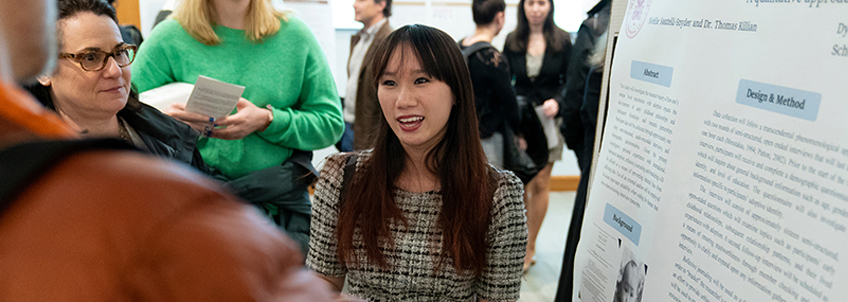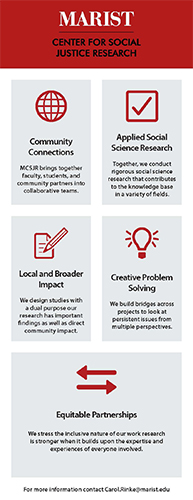-
About
First-Year Application Deadline
Don't miss your chance to apply to Marist and join the Red Fox Family!
• Early Decision II and Regular Decision: Sunday, Feb. 15About
-
Academics
First-Year Application Deadline
Don't miss your chance to apply to Marist and join the Red Fox Family!
• Early Decision II and Regular Decision: Sunday, Feb. 15Academics
-
Admission & Financial Aid
First-Year Application Deadline
Don't miss your chance to apply to Marist and join the Red Fox Family!
• Early Decision II and Regular Decision: Sunday, Feb. 15Admission & Financial Aid
-
Student Life
First-Year Application Deadline
Don't miss your chance to apply to Marist and join the Red Fox Family!
• Early Decision II and Regular Decision: Sunday, Feb. 15Student Life
- Athletics
Image of Marist students from the School of Social and Behavioral Sciences working with children in the Teaching Lab.
School of Social and Behavioral Sciences
Student Research
In the School of Social and Behavioral Sciences, we understand the growing interest of our students to be principal investigators in research projects. This is why we provide our students the unique opportunity to engage with faculty on a variety of research topics both inside and outside the classroom. Faculty work with students to collect and analyze data, as well as to present their findings at both regional and national conferences within the fields of Criminal Justice, Education, Psychology, and Social Work.

Faculty Research Labs
Social and Behavioral Sciences faculty run labs with established programs of research. These labs address a variety of vital research topics, from intriguing psychological processes to to applied work in psychopathology, mindfulness, prejudice, social welfare, special needs students' curriculum development, and so much more. Undergraduate and graduate students have the opportunity to get involved in one of the current faculty-led research labs or propose their own student-directed study. All students involved in research receive mentorship on study design, data collection, and analysis processes. Students may also apply for funding to support their efforts. Students have presented their work at a variety of on- and off-campus venues such as:
-
Marist’s Celebration of Undergraduate Student Research and Creative Activity
- Marist’s Explorations in Social Justice Conference
- Eastern Psychological Association
- Council for Exceptional Children
- Social Work Student Advocacy Research Conference
- Academy for Criminal Justice Sciences
Students interested in joining a faculty-mentored research lab should contact the department chair of their respective department.
Marist Center for Social Justice Research (MCSJR)
The Marist Center for Social Justice Research (MCSJR) is an interdisciplinary research center across the School of Social and Behavioral Sciences. MCSJR brings together faculty, students and community partners into collaborative teams to conduct applied social science research.
All MCSJR studies have a dual purpose: they build rigorous new knowledge in the content area while also making a direct impact on the Mid-Hudson Valley region. MCSJR teams also emphasize equitable partnerships and cross-project dialogue. Students, faculty, and community partners have presented at local as well as national conferences and conducted workshops on the process of building a program of engaged research.
Faculty-Sponsored Student Research Projects
Eastern Psychological Association, 2023
* indicates student participation, bold indicates faculty advisor
*Behuniak & Trent. The effects of mask wearing and participant gender on perceived threat.
*Maltby & Glick. Relationship jet leg in first-year undergraduates: long-distance romantic relationships and social-emotional adjustment.
*Brea, *McMillan, *Peters, *Cutaneo & Stone. Observed cognitive, behavioral, and academic differences among ENL and non-ENL kindergarteners.
*Perri, *Germain, *Franchi, & Levering. The influence of brief fake news training on the illusory truth effect.
*Mende, *Swift, *Verlotte, Dovgan, Fredrick, Fingerhut. The lack of gender, sexuality, and ability diversity in children's literature.
*Peters, *Brea, *Cutaneo, *McMillan, Stone. The impact of a mindfulness-based intervention to school climate in kindergarten classrooms.
*Janton & Glick. Examining the social-emotional benefits of Greek life during the transition to college.
*Kossman & Levering. The effects of customer incivility on summer workers.
*Milito & Trent. Mobilizing individuals in a digital world: do Instagram posts influence civic engagement?
*Peters, *Brea, *Cutaneo, *McMillan & Stone. The impact of a mindfulness-based intervention to school climate in kindergarten classrooms.
*Ackerler, *Maltby, *Ferro, *Kasarci & Dovgan. Caffeine's effect on alertness in undergraduate students: a blind experiment.
*Mattern, *Egbokwu & Fredrick. Impact of diversity, equity, & inclusion courses on acceptance & awareness.
*Koonce & Levering. Measuring racial essentialism among the general population.
*Brea, *Mcmillan, *Peters, *Cutaneo & Stone. Observed cognitive, behavioral, and academic differences among ENL and non-ENL kindergarteners.
Fredrick & Mann. It's not just bathroom bills: Bathroom access for trans and non-binary students.
